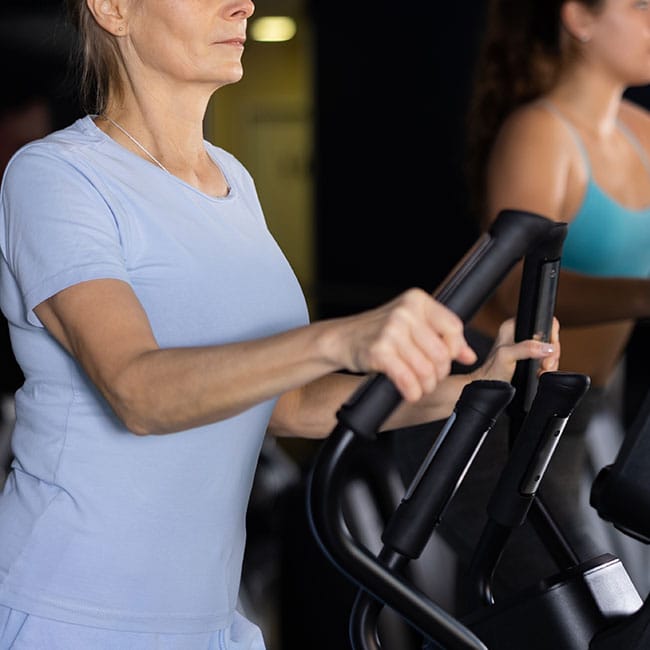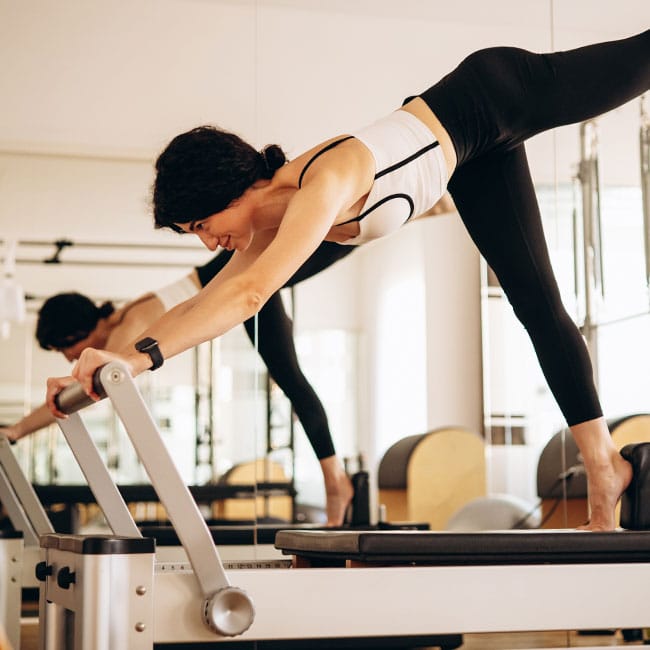This is an archived article and the information in the story may be outdated. Please check the time stamp on the story to see when it was updated last.
We all know that there are two very important steps to fitness: eating well and exercising. And exercise doesn’t always mean high intensity, cardio workouts. Sometimes it is as simple as starting your morning with a stretch.
If you’re looking to strengthen your abs for a flatter tummy, stretching can do wonders for your goals. It seems too simple to be true, but experts can confirm it.
“When it comes to slimming your waistline, incorporating strength training, a well-balanced diet, and cardiovascular activities into your routine will all help point you in the right direction! Stretching is also beneficial, but the caloric burn from stretching will most typically only be seen if one is completely new to exercise,” fitness writer and certified personal trainer Hanna Daugherty told SheFinds. “If you are aiming to reduce fat and tone your torso, then performing core strengthening movements such as side planks, leg lowers, bicycles, and mountain climbers into your routine will have you seeing a tighter core!”
So we spoke to some trainers to learn some simple morning stretches that will help support a flat tummy and waist. This is what they say you should try:


Upward Plank
“[The Upward Plank] is a fantastic pose that activates every part of the body - the legs, glutes, back, core, arms and even neck are all engaged,” Amit Gami of Amsat Yoga advised SheFinds. “One of the reasons why it's so effective is the concentration of energy at the core. Lifting the torse high off the ground results in a high center of gravity, more so than a traditional plank, meaning that the amount of energy to sustain this pose is increased. With such great effort comes great rewards and this comes in the form of a high level of stomach definition.”
How To Do The Upward Plank Pose
1. Start sitting on the floor with your legs extended in front of you.
2. Place your hands a few inches behind your hips, shoulder-distance apart with palms facing down and fingertips pointing towards your body.
3. Lift your hips up toward the ceiling, pressing your hands and feet down firmly into the floor.
4. Hold the position for 1-3 breaths.
When in an Upward Plank, your body should be lifted in one straight line from your feet to your shoulders, with your back facing the floor and front facing the ceiling.

Downward-Facing Dog
“Shaping the waist requires working on the abdominal muscles, and while it takes balanced nutrition and cardio training, proper stretching techniques can also do the trick,” Darryl Higgins, founder of Athlete Desk, told us. “As a health and fitness enthusiast, it is important to note that not all abdominal exercises are great for the waist, some expand it.”
He recommends doing the Downward-Facing Dog stretch because it can “help you attain a flat tummy and tiny waist.” “You might've heard much about this pose for its therapeutic aid for sciatica and relieves fatigue,” Higgins said. “For back problems that can affect your sleep and leave you achy and tired, try this stretching technique to relieve back pains. As a result, this strengthens your core muscles, tightening your tummy.”
How To Do The Downward-Facing Dog Pose
1. Start with a simple push-up position with your body parallel to the ground.
2. Lift your hips upwards towards the back of the room while straightening your arms.
3. Gently press your stomach towards your thighs and relax your breathing.
4. Hold the position for 1-3 breaths.
When in Downward-Facing Dog, your body should be in a triangular shape, with the ground acting as the base of the triangle.

Kneeling Hip Flexor Stretch
“[The Kneeling Hip Flexor] is the stretch you need to do every morning to flatten your tummy,” said Josh Schlottman, trainer at Josh Fitness. “You might have an overextended belly that's causing a pooch to stick out when you really don't have that much belly fat in the first place.”
He continued, “Bringing your hips back into their proper alignment is key to flattening your stomach. Sitting too much can cause your hip flexors to overtighten which pushes your butt back and your tummy forward. This is called an anterior pelvic tilt and causes your gut to protrude. This hip flexor stretch will realign your posture into the correct position, resulting in a slimmer and flatter tummy.”
How To Do The Kneeling Hip Flexor Stretch
1. Start off kneeling on both knees, then lift your right knee up and place your right foot flat on the floor in front of you.
2. Keep both knees bent at a 90 degree angle and make sure your feet are in line with your hips.
3. Tilt your pelvis upwards and hold it there as you move your hips forward until you feel a stretch in the front of your hip.
4. Hold this position as you lift your left arm up over your right leg reaching upwards.
After you’ve held the position for 30 to 60 seconds, repeat the entire process on the other side.

Side Plank
“We like the side plank for core and stomach work,” Trainer Paul Johnson, founder of Complete Tri, told SheFinds. “It is an exercise that hits your obliques, and there aren’t many other core exercises that really target the area.”
He added, “Most stomach exercises are going to work with abs. Abs are important, but obliques make up lots of the area in your midsection. You can’t ignore them.
“Working your obliques will allow you to hold the sides of your core in tighter with better posture, which may provide the appearance of a trimmer overall waistline. It will also translate to better performance in everything from cycling to yoga.”
How To Do The Side Plank Pose
1. Start in a classic plank pose, holding yourself up on your palms and toes with your body lifted off the ground.
2. Roll both heels to the right side, stacking your left foot on top of the right and keeping your core engaged.
3. Press down through the right hand as you raise your left hand toward the ceiling
4. Hold the position for 2-5 breaths.
Repeat the entire process on the other side.
When in an Upward Plank, your body should be lifted in one straight line from your feet to your shoulders, with your sides each facing the walls of the room.


























